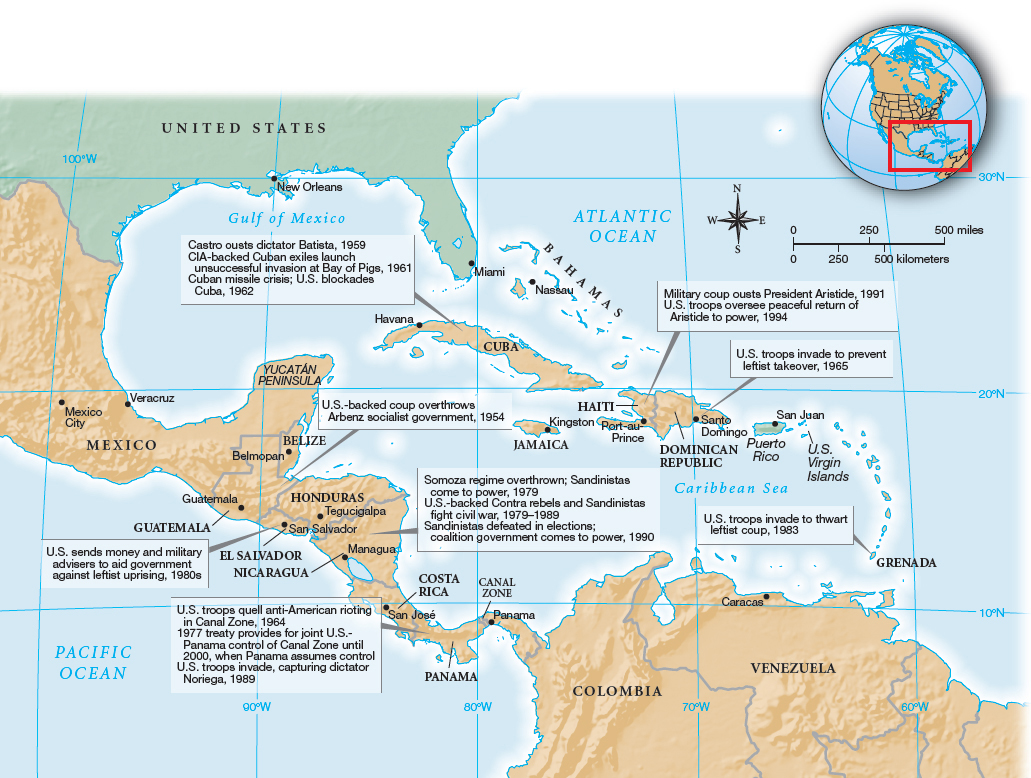Meeting the “Hour of Maximum Danger”
Printed Page 870
Underlying Kennedy’s foreign policy was an assumption that the United States had “gone soft — physically, mentally, spiritually soft,” as he put it in 1960. Calling the Eisenhower era “years of drift and impotency,” Kennedy warned in his inaugural address that the nation faced a grave peril: “Each day the crises multiply. … Each day we draw nearer the hour of maximum danger.”
CHAPTER LOCATOR
How did U.S. foreign policy change under Kennedy?
Why did Johnson escalate American involvement in Vietnam?
How did the war in Vietnam polarize the nation?
How did U.S. foreign policy change under Nixon?
Conclusion: Was Vietnam an unwinnable war?
 LearningCurve
LearningCurve
Check what you know.
bedfordstmartins.com/roarkunderstanding
Although the president exaggerated the threat to national security, several developments in 1961 heightened the sense of crisis and provided a rationalization for his military buildup. Shortly before Kennedy’s inauguration, Soviet leader Nikita Khrushchev publicly encouraged “wars of national liberation,” thereby aligning the Soviet Union with independence movements in the third world that were often anti-Western. His statement reflected in part the Soviet competition with China for the allegiance of emerging nations, but U.S. officials saw it as a threat to the status quo of containment.
Cuba, just ninety miles off the Florida coast, posed the first crisis for Kennedy. The revolution led by Fidel Castro had moved Cuba into the Soviet orbit, and Eisenhower’s Central Intelligence Agency (CIA) had been planning an invasion of the island by Cuban exiles living in Florida. Kennedy ordered the invasion to proceed even though his military advisers gave it only a fair chance of success.
On April 17, 1961, about 1,400 anti-Castro exiles trained and armed by the CIA landed at the Bay of Pigs on the south shore of Cuba (Map 29.1). Contrary to U.S. expectations, no popular uprising materialized to support the anti-Castro brigade. Kennedy refused to provide direct military support, and the invaders quickly fell to Castro’s forces. The disaster humiliated Kennedy and the United States, posing a stark contrast to the president’s inaugural promise of a new, more effective foreign policy. And it alienated Latin Americans who saw it as another example of Yankee imperialism.

 Failed U.S.-sponsored invasion of Cuba in 1961 by anti-Castro forces who planned to overthrow Fidel Castro’s government. The disaster humiliated Kennedy and the United States. It alienated Latin Americans who saw the invasion as another example of Yankee imperialism.
Failed U.S.-sponsored invasion of Cuba in 1961 by anti-Castro forces who planned to overthrow Fidel Castro’s government. The disaster humiliated Kennedy and the United States. It alienated Latin Americans who saw the invasion as another example of Yankee imperialism.
Days before the Bay of Pigs invasion, the Soviet Union delivered a psychological blow when a Soviet astronaut became the first human to orbit the earth. Kennedy then called for a huge new commitment to the space program, with the goal of sending a man to the moon by 1970. Congress authorized the Apollo program and boosted appropriations for space exploration. John H. Glenn orbited the earth in 1962, and the United States beat the Soviets to the moon, landing two astronauts there in 1969.
 Project initiated by John F. Kennedy in 1961 to surpass the Soviet Union in space exploration and send a man to the moon.
Project initiated by John F. Kennedy in 1961 to surpass the Soviet Union in space exploration and send a man to the moon.
Kennedy determined to show American toughness to Khrushchev, but when the two met in June 1961 in Vienna, Austria, Khrushchev took the offensive. The stunned Kennedy reported privately, “He just beat [the] hell out of me. … If he thinks I’m inexperienced and have no guts … we won’t get anywhere with him.” Khrushchev demanded an agreement recognizing the existence of two Germanys, and he threatened America’s occupation rights in and access to West Berlin.
Khrushchev was concerned about the massive exodus of East Germans into West Berlin, a major embarrassment for the Communists. To stop this flow, in August 1961 East Germany erected a wall between East and West Berlin. With the Berlin Wall stemming the tide of escapees and Kennedy declaring West Berlin “the great testing place of Western courage and will,” Khrushchev backed off from his threats.
 Structure erected by East Germany in 1961 to stop the massive exodus of East Germans into West Berlin, which was an embarrassment to the Communists.
Structure erected by East Germany in 1961 to stop the massive exodus of East Germans into West Berlin, which was an embarrassment to the Communists.
Kennedy used the Berlin crisis to add $3.2 billion to the defense budget. He increased draft calls, and he also mobilized the reserves and National Guard, adding 300,000 troops to the military. This buildup of conventional forces provided for a “flexible response,” offering “a wider choice than humiliation or all-out nuclear action.”